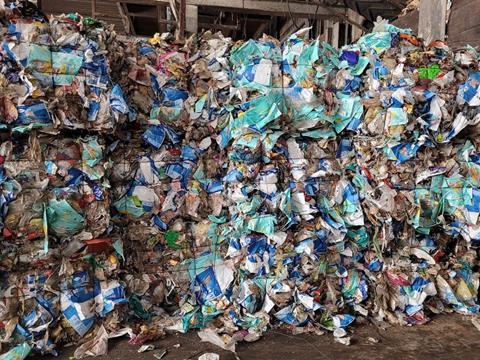
The HolyGrail 2.0 Initiative has announced the successful validation of digital watermarking technology in combination with NIR for advanced sorting of flexible packaging, with a focus on the separation of hygiene-grade LDPE films and food-grade PP films.
The obtained results reportedly enable the creation of new higher-quality recycling streams at efficiency levels not currently possible with other technologies.
Advanced sortation using digital watermark technology from provider Digimarc and add-on module from machine vendor Pellenc ST was successfully validated in an industrial setting at Hündgen Entsorgung’s material recovery facility (MRF) for separating flexible packaging.
The trial took place between December 2023 and February 2024 under the supervision of the HolyGrail 2.0 technical team. Tests were performed on real streams that were bulked up with additional quantities of digitally watermarked PP films, as well as LDPE films produced by brand owners Essity, Kraft Heinz, PepsiCo and Procter & Gamble.
The focus was on sorting flexible packaging to create specific types of output fractions – food-grade PP flexibles and hygiene-grade PE flexibles – from a mixed waste stream.
For the December 2023 assessments, the results apparently demonstrated, on average >95% detection efficiencies, >85% sorting efficiencies, and >70% purity. These results were from single-pass sorting. It is expected that two-pass sorting, typically used in recycling plants, will further improve the purity of the output fractions with around 20%.
For the further contaminated, baled, and aged streams in the February 2024 assessments, the results for single-pass sorting achieved 89.9% detection efficiency, 75.1% sorting efficiency, while purity was 88.1%.
Although the extreme conditions (i.e. multiple baling/unbaling, mix of flexibles and rigids, high throughputs up to 2500 kg/h, dirtier) of the February assessments had a large impact on the marked surface, HolyGrail says that the impact on the detection efficiency was relatively small for the tested fractions.
The overall sorting results were reportedly consistent from run to run, in spite of operating conditions during the trials, which are not reflective of normal industrial settings and were generally harsher than expected for such flexible packaging due to a combination of factors – notably higher and variable throughput, the presence of both flexibles and rigids in the waste stream during sorting, and more baling than usual. Based on these observations, it is estimated that for flexible packaging, the December results are more indicative of the performance of a single sorting step in practice.
At the same site, the team is preparing to commence a three-month trial to sort post-consumer digitally watermarked rigid packaging introduced to the Danish and German markets by various HG2.0 member companies.
This will be supported by two fully functional prototypes jointly developed by Pellenc ST and Digimarc, which will be installed on the commercial sorting line of Hündgen Entsorgung.
If successful, the companies believe that this test will further validate the detection and sorting capability of the technology in an industrial setting, as well as the robustness of the system, indicating the technology has reached TRL 9 – watermark-based sorting proven in an operational environment.
Two industrial-sized recycling tests with the sorted material will then complete Phase 3: Testing of the PP films and PE flexible fractions collected at Hündgen Entsorgung is being undertaken by Borealis, whereas testing of the separated non-food PET bottle stream resulting from the rigid trial, will take place at another site.
If you liked this story, you might also enjoy:
How are the top brands progressing on packaging sustainability?
Sustainable Innovation Report 2024: Current trends and future priorities
Reuse vs. single use – which is better for the environment?
The ultimate guide to global plastic sustainability regulation












No comments yet